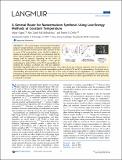A General Route for Nanoemulsion Synthesis Using Low-Energy Methods at Constant Temperature
Author(s)
Gupta, Ankur; Badruddoza, Abu Zayed Md; Doyle, Patrick S
DownloadAccepted version (2.380Mb)
Terms of use
Metadata
Show full item recordAbstract
© 2017 American Chemical Society. The central dogma of nanoemulsion formation using low-energy methods at constant temperature - popularly known as the emulsion inversion point (EIP) method - is that to create O/W nanoemulsions, water should be added to a mixture of an oil and surfactant. Here, we demonstrate that the above order of mixing is not universal and a reverse order of mixing could be superior, depending on the choice of surfactant and liquid phases. We propose a more general methodology to make O/W as well as W/O nanoemulsions by studying the variation of droplet size with the surfactant hydrophilic-lypophilic balance for several model systems. Our analysis shows that surfactant migration from the initial phase to the interface is the critical step for successful nanoemulsion synthesis of both O/W and W/O nanoemulsions. On the basis of our understanding and experimental results, we utilize the reverse order of mixing for two applications: (1) crystallization and formulation of pharmaceutical drugs with faster dissolution rates and (2) synthesis of alginate-based nanogels. The general route provides insights into nanoemulsion formation through low-energy methods and also opens up possibilities that were previously overlooked in the field.
Date issued
2017Department
Massachusetts Institute of Technology. Department of Chemical EngineeringJournal
Langmuir
Publisher
American Chemical Society (ACS)